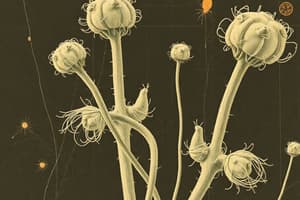Podcast
Questions and Answers
Which of the following is a characteristic of asexual reproduction in animals?
Which of the following is a characteristic of asexual reproduction in animals?
- Offspring are genetically different from their parent
- Offspring are mostly observed in higher organisms
- Offspring are genetically identical to each other and to their parent (correct)
- Offspring require two parents for reproduction
What is the process whereby a cell divides asexually to produce two daughter cells called?
What is the process whereby a cell divides asexually to produce two daughter cells called?
- Fusion
- Binary Fusion (correct)
- Parthenogenesis
- Meiosis
In what type of reproduction does an egg develop into a new individual without fertilization?
In what type of reproduction does an egg develop into a new individual without fertilization?
- Parthenogenesis (correct)
- Hermaphroditism
- Binary Fission
- Fusion
Which animals may exhibit hermaphroditism and can self-fertilize or mate with another of their species?
Which animals may exhibit hermaphroditism and can self-fertilize or mate with another of their species?
Which process occurs in prokaryotic microorganisms and some invertebrate, multi-celled organisms?
Which process occurs in prokaryotic microorganisms and some invertebrate, multi-celled organisms?
Which type of reproduction is mostly observed in lower organisms and unicellular microbes such as amoeba, euglena, and bacteria?
Which type of reproduction is mostly observed in lower organisms and unicellular microbes such as amoeba, euglena, and bacteria?
What is the result of asexual reproduction in animals?
What is the result of asexual reproduction in animals?
Which type of reproduction involves a form of asexual reproduction where an egg develops into a new individual without fertilization?
Which type of reproduction involves a form of asexual reproduction where an egg develops into a new individual without fertilization?
Flashcards are hidden until you start studying
Study Notes
Asexual reproduction in animals is a type of reproduction that occurs without the involvement of two parents. This process results in offspring that are genetically identical to each other and to their parent and is mostly observed in lower organisms and unicellular microbes such as amoeba and euglena and bacteria and some eukaryotic animals like earthworms, slugs, tapeworms, and snails that are often hermaphroditic and can self-fertilize or mate with another of their species to produce offspring.
Asexual reproduction in animals can occur through different methods, such as:
-
Binary Fission: This process occurs in prokaryotic microorganisms and some invertebrate, multi-celled organisms. The parent cell undergoes mitosis, and the nucleus also divides, producing two identical daughter cells and
-
Fission: Also called binary fission, it is the process whereby a cell divides asexually to produce two daughter cells
-
Parthenogenesis: This is a form of asexual reproduction where an egg develops into a new individual without fertilization
-
Hermaphroditism: In animals where one individual has both male and female reproductive parts, such as earthworms, slugs, tapeworms, and snails, hermaphroditism may occur. These animals can self-fertilize or mate with another of their species, fertilizing each other and both producing offspring
Asexual reproduction in animals has both disadvantates
Studying That Suits You
Use AI to generate personalized quizzes and flashcards to suit your learning preferences.




